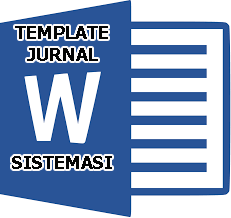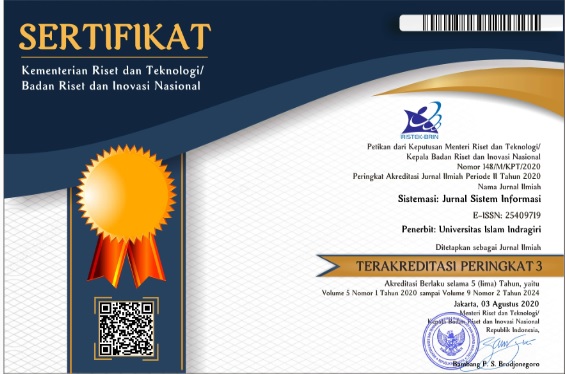Sales Data Visualization to Determine Business Insight Using Metabase in a Global Retail Company
Abstract
Full Text:
PDFReferences
S. N. Zahra and P. E. P. Utomo, “Visualisasi Data Penjualan Barang Retail di Seluruh Dunia Menggunakan Tableau,” J. Nas. Ilmu Komput., vol. 4, no. 3, pp. 12–21, 2023, doi: 10.47747/jurnalnik.v4i3.1217.
R. Rafid Adityo, “Pengembangan Aplikasi Qiscus Meet Menggunakan Jitsi Open Source Framework,” 2022.
D. Triyanto, M. Sholeh, F. H.-K. K. I. I. dan, and undefined 2023, “Implementasi Business Intelligence Menggunakan Tableau Untuk Visualisasi Data Dampak Bencana Banjir di Indonesia,” Djournals.Com, vol. 3, no. 6, pp. 586–594, 2023, doi: 10.30865/klik.v3i6.769.
T. Purwani, A. Wahyuni, A. P. Wicaksono, H. D. Charunia, J. Tengah, and P. Skateboard, “DASHBOARD UNTUK VISUALISASI DATA PENJUALAN BARANG PADA TOKO PUPPETS SKATEBOARD SEMARANG pengelolaan data adalah Tableau . Penelitian yang dilakukan oleh Patrick Setiawan ( Patrick Setiawan ,”.
K. Gudang, U. D. Salim, T. Aristi, S. Muharni, and A. Perdana, “Pemanfaatan Google Data Studio Untuk Visualisasi Data Bagi,” vol. 2, no. 2, pp. 67–72, 2021.
D. Naista and M. S. Hasibuan, “Visualisasi Data Hasil Uji Kompetensi Jurusan Rekayasa Perangkat Lunak SMK Negeri 3 Metro Oleh Dinas Perindustrian dan Perdagangan Provinsi Lampung 2021,” pp. 115–122, 2022.
J. Prima et al., “ANALISIS BIG DATA DENGAN METODE EXPLORATORY DATA ANALYSIS ( EDA ) DAN METODE VISUALISASI MENGGUNAKAN JUPYTER NOTEBOOK,” vol. 4, no. 2, pp. 2–6, 2021.
B. All Habsy, N. Mufidha, C. Shelomita, I. Rahayu, and M. Ilham Muckorobin, “INDONESIAN JOURNAL OF EDUCATIONAL COUNSELING Filsafat Dasar dalam Konseling Psikoanalisis : Studi Literatur A rt icle H ist o ry A B ST RA CT,” Indones. J. Educ. Couns., vol. 7, no. 2, pp. 189–199, 2023, doi: 10.30653/001.202372.266.
H. Nuraliza, O. N. Pratiwi, and F. Hamami, “Analisis Sentimen IMBd Film Review Dataset Menggunakan Support Vector Machine (SVM) dan Seleksi Feature Importance,” J. Mirai Manaj., vol. 7, no. 1, pp. 1–17, 2022.
N. K. Zuhal, “Study Comparison K-Means Clustering dengan Algoritma Hierarchical Clustering,” Pros. Semin. Nas. Teknol. dan Sains, vol. 1, pp. 200–205, 2022, [Online]. Available: https://jurnal.dharmawangsa.ac.id/index.php/djtechno/article/view/966/867
G. Gustientiedina, M. H. Adiya, and Y. Desnelita, “Penerapan Algoritma K-Means Untuk Clustering Data Obat-Obatan,” J. Nas. Teknol. dan Sist. Inf., vol. 5, no. 1, pp. 17–24, 2019, doi: 10.25077/teknosi.v5i1.2019.17-24.
D. Subuh and W. Yasman, “Implementasi Data Warehouse Dan Penerapannya Pada Toko Magnifique Clothes Dengan Menggunakan Tools Pentaho,” Semin. Nas. Inov. dan Apl. Teknol. di Ind., pp. 29–36, 2019.
Y. Suhanda, I. Kurniati, and S. Norma, “Penerapan Metode Crisp-DM Dengan Algoritma K-Means Clustering Untuk Segmentasi Mahasiswa Berdasarkan Kualitas Akademik,” J. Teknol. Inform. dan Komput., vol. 6, no. 2, pp. 12–20, 2020, doi: 10.37012/jtik.v6i2.299.
B. H. Assyafah and T. D. Yulianti, “Analisis Dataset menggunakan Sentiment Analysis (Studi Kasus Pada Tripadvisor),” J. Strateg., vol. 3, no. November, pp. 320–331, 2021, [Online]. Available: https://www.kaggle.com/andrewmvd/trip-advisor-hotel-reviews
A. Fahri and Y. Ramdhani, “Visualisasi Data dan Penerapan Machine Learning Menggunakan Decision Tree Untuk Keputusan Layanan Kesehatan COVID-19,” J. Tekno Kompak, vol. 17, no. 2, pp. 50–60, 2022, [Online]. Available: https://ejurnal.teknokrat.ac.id/index.php/teknokompak/article/view/2438%0Ahttps://ejurnal.teknokrat.ac.id/index.php/teknokompak/article/download/2438/1257
DOI: https://doi.org/10.32520/stmsi.v13i4.3870
Article Metrics
Abstract view : 850 timesPDF - 271 times
Refbacks
- There are currently no refbacks.

This work is licensed under a Creative Commons Attribution-ShareAlike 4.0 International License.









